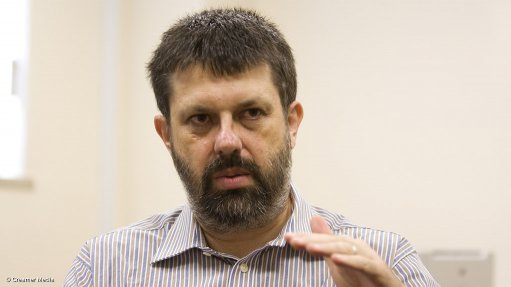
CMMS director Declan Vogt
Photo by: Duane Daws
JOHANNESBURG (miningweekly.com) – Three-hundred people a year are doing courses in mechanised mining offered by the University of the Witwatersrand Centre for Mechanised Mining Systems (CMMS).
CMMS director Dr Declan Vogt, who was interviewed by Mining Weekly Online at the university, sees one of the centre’s main roles as raising the skills levels of those destined to manage mechanised sections in mines.
The CMMS’ view is that South African mining needs to mechanise to become more productive, against the background of the drop in mining productivity, which has put the industry under pressure to up its game.
To assist in meeting that need, the Wits centre is providing education and training for supervisor-level line management through a series of postgraduate courses, which are presented as short courses or as part of a degree.
Another of the centre’s roles is to be a thought leader in identifying best practice for mechanised mining aspirants.
Courses currently proving popular are at master’s degree level and at National Qualifications Framework (NQF) Level 9, with consideration being given to extending courses to NQF Level 6, to enable mine personnel, including shift bosses, to become certified in mechanised mining.
The CMMS is sponsored by companies including Anglo American, Anglo American Platinum, African Rainbow Minerals and Impala Platinum as mining partners; Atlas Copco, Sandvik and Joy as equipment partners; and Hatch and WorleyParsons as consulting company partners.
Mechanised mining and general modernisation are helping to make South African mines more efficient.
“If you look at the lowest-cost producers, all are mechanised,” says Vogt.
Remotely controlled low-profile equipment has been introduced for the drilling and blasting of platinum reef in restricted 1.2 m stope heights and work is being done to ensure that roof bolting solutions match the new mining efficiencies, along with the development of the necessary skills.
Mining Weekly Online can also report that gold mining company AngloGold Ashanti has developed and manufactured prototypes in a relatively short time to mine the gold alone using a non-drill-and-blast reef boring technology, which has already produced more than 2 000 oz of gold in a pillar-mining exercise.
While technical solutions are invariably available, implementation often proves tougher and, because several attempts to introduce mechanised mining have floundered on systems failures, the CMMS is adopting a systems and operational redesign approach.
Vogt sees it as essential to have the required number of skilled people to operate and maintain machines and he would like to see far more graduates also emerging from further education and training colleges to fill the maintenance needs of mechanisation in particular.